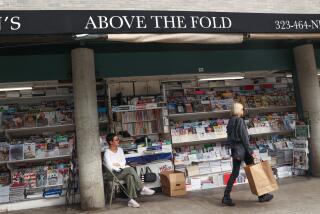Loss of a Newspaper Rattles S.F.
- Share via
SAN FRANCISCO — California’s last two-newspaper city is poised to become a one-newspaper city, and the result is a civic free-for-all rife with celebrity bashing, a federal investigation, a state investigation, two city investigations, seething self-interest and a welter of resentments.
The storied San Francisco Chronicle was sold this summer to the Hearst Corp., owner of its bitter rival of 100 years, the equally storied San Francisco Examiner. The continuing commotion highlights just how Balkanized life is in this beautiful but bellicose small town with its metropolitan pretensions.
Everything here is a Big Deal; this has become a Really Big Deal.
Mergers are commonplace these days, and afternoon daily newspapers, like the Examiner, are an acknowledged endangered species. But the sale of the morning Chronicle, and the possibility that it could swallow the Examiner whole, has alarmed the city’s various minority communities, which fear diminished coverage of all things gay, lesbian, bisexual, transgender, black, Latino, Asian and other.
And along the way, it has opened up a slightly smeary window onto the grudges that rend politics and special interests here.
Like the grudge nursed by the city’s No. 3 paper (the free, thrice-weekly Independent) against the giant Hearst. One columnist, who wears an eye patch and goes nowhere without a basset hound named Melman, describes his paper’s efforts as “a holy crusade” against the New York-based media empire.
This nasty little David-against-Goliath spat features a huge four-color weekly comic called Mr. Stone (a dig at Examiner Executive Editor Phil Bronstein, who is married to actress Sharon Stone) and banner headlines like “DON’T LET YELLOW JOURNALISM MONOPOLIZE SAN FRANCISCO!”
“Everyone you talk to in San Francisco, you have to sit back and figure out what their agenda is,” complained one U.S. Justice Department official investigating the sale’s antitrust implications. “Because everyone has an agenda.”
If he only knew.
The way Dist. Atty. Terence Hallinan sees it, “This is not a city that takes anything lying down. . . . It’s not easy to be a politician in, but it’s a great city.”
Hallinan is embroiled in a bitter reelection battle playing out on Page 1 of all of the aforementioned publications, among others, and has launched an official probe into the terms of the newspaper sale and whether it is legal.
It was last June that the Chronicle board of directors put the 134-year-old family-owned paper, with a daily circulation of 482,268, on the block. Two months later, Hearst put an end to rampant speculation by announcing that it would buy the Chronicle itself and put the Examiner, circulation 111,000, up for sale. If no buyer came forward in three to six weeks, the company said at the time, the Examiner would be merged into its rival. Everyone would have a job, executives promised.
Fast forward 11 weeks. No sale has been announced, although the Phoenix-based New Times company, which publishes the alternative San Francisco Weekly, has offered to buy the Examiner’s racks and vending machines.
Examiner writers have been assigned stories for their publication’s final commemorative edition. But the two newsrooms are mostly quiet, simply because there’s little new information to talk about. Since the Justice Department began its antitrust investigation, it has enforced silence on top Chronicle and Examiner management and local officials. Bronstein and Jerry Roberts, the Chronicle managing editor, declined comment for this article.
Both papers had buzzed for months about just what a hybrid could possibly look like after a century at each other’s throats.
Historically, the Chronicle has always viewed itself as the broader, more serious, more regional paper while the combative Examiner has focused more closely on the inner workings of San Francisco, its neighborhoods and its politics.
In the booming 1980s, for example, rapid development was changing the city’s skyline. The Chronicle’s Allan Temko, who later won a Pulitzer Prize for architecture criticism, weighed in on the aesthetics of the new construction. The Examiner investigated whose palms were greased to get the skyscrapers built.
The only time the fierce rivals ever really collaborated was the day after the 1906 quake, when they joined with the Oakland Tribune to print a combined edition across the bay.
The sale set off rampant speculation: Who would take the helm of the new Hearst-owned Chronicle? Would it be the Examiner’s flamboyant Bronstein? The staffs of the two papers figured someone would get the ax, for no newspaper needs two reporting teams covering everything from baseball to City Hall, two top editors or too many columnists.
Shortly after the Chronicle announced it was for sale, columnist Jon Carroll wrote that he suddenly remembered how much he admired Sharon Stone’s acting abilities, particularly in the widely panned “Sphere.”
“The overrated Gwyneth Paltrow can take a back seat to Stone, and Oscar was foolish indeed to overlook her stunning portrayal of the suicidal marine biologist,” he cracked. “She was the best suicidal marine biologist in movie history, and I am not ashamed to say so.”
City, State and Feds Probing the Legalities
Even harder for many to imagine is how any paper could combine the staffs’ disparate philosophies. “It’s a little bit like getting the Serbs and Kosovars to live together after NATO comes in,” posits Orville Schell, dean of the graduate school of journalism at UC Berkeley.
With everyone in town staking out a position on the sale, City Atty. Louise Renne has launched her own probe into the sale. State Atty. Gen. Bill Lockyer is also looking into the terms of the sale. And the Justice Department, which actually has the most authority in the matter, has had agents in town for weeks interviewing interested parties.
Although all agencies have declined extensive comment, officials acknowledge that the focus of the examinations is the antitrust implications of merging two papers that have functioned for the past 34 years under a so-called Joint Operating Agreement.
The JOA allowed the publications to share noneditorial operations, such as circulation and printing, and split profits until 2005, in an effort to protect their competing voices. Under the federally sanctioned agreement, both dailies publish separately six days a week; on Sunday, when the circulation jumps to 605,354, the Examiner produces the main news sections and the Chronicle produces several feature sections.
Critics have argued that the JOA allowed an afternoon paper with slumping circulation to struggle along instead of dying a natural death, and sapped the life out of both publications.
But now that San Francisco--a city with more opinions than there are issues to disagree on--is about to lose one of its more pointed voices, everyone has something to say about it.
Mayor Willie Brown, who is up for reelection, has written to Atty. Gen. Janet Reno decrying a “news monopoly” that could result. The Board of Supervisors voted--together--to elicit testimony on the sale and possible merger. But members split up when it came time to complain about what might happen to various special interests if the Examiner disappeared.
Two Asian American supervisors held a news conference questioning whether San Francisco’s ethnic minorities would suffer. The board’s three gay and lesbian supervisors held a separate news conference asking that the Justice Department consider the impact on coverage of homosexual issues if the Examiner disappears.
“Award-winning mainstream coverage of important gay issues such as hate crimes, AIDS, domestic partners and diversity within the gay community resulted because of real competition,” said Tom Ammiano, a gay activist and president of the Board of Supervisors.
Among the organizations that oppose a merger are the Irish American Democratic Club, the Council of District Merchants, the Latino Peace Officer Assn., the Harvey Milk Lesbian/Gay/Bisexual/Transgender Democratic Club, the African American Democratic Club and the Filipino American Democratic Club.
Letters to the editor in both papers have expressed dismay over the loss of a singular San Francisco institution. “The Hearst Corp. has bought the Chronicle?” wrote one incredulous reader. “The mind rebels, the heart sinks.”
And at a hearing Tuesday of a city finance committee, there were calls for San Francisco to sue the newspapers to stop the sale and questions about whether the sale was even on the up-and-up to begin with.
“The sale of the Chronicle to Hearst is not yet final,” said Stephen R. Barnett, a professor at UC Berkeley’s Boalt School of Law, who specializes in joint operating agreements. “It is under review by the Justice Department. I suggest that Justice could and should require that the sale be reopened and other buyers--buyers who do not own San Francisco’s other daily--be given a chance to bid.”
Such a level of concern and activity surrounding the possible loss of a newspaper “is unusual,” said James Naughton, president of the Poynter Institute, a nonprofit Florida center for journalism education. “I’d also be very surprised if it’s successful. In the end, I don’t know of any obligation to continue publishing a money-losing paper.”
Competing Publisher Fears a Monopoly
Some of those protesting the Chronicle sale have stronger interests in the outcome than others. Like the Fang family, several generations of powerful Chinese Americans who are loyal supporters of Mayor Brown and who publish the Independent and the tabloid Asian Week.
Since Hearst announced that it would buy the Chronicle and try to sell the Examiner, nearly every edition of the Independent has splashed some nuance of the story across Page 1 in an effort to halt what it considers a budding monopoly.
The Oct. 19 edition featured a full-page orange devil (Cut Here. Free Trick-or-Treat Mask) reading a newspaper with the headline “The Hearst Chronicles Merger From Hell. Damned Readers to Pay.” A month earlier came the full-page Chronopoly board, “The Participatory Media Game Where Only One Player Can Win.” In addition, the Independent created the Committee to Stop the Hearst Monopoly.
Several grudges intertwine here, largely over the Independent’s financial survival. The free community paper, with a circulation of about 250,000 in San Francisco, has been locked in a years-long court battle with the Examiner over which gets the lucrative contract to print the city’s legal advertising.
In addition, under the terms of the JOA, neither the Chronicle nor the Examiner were allowed to publish a free community newspaper like the Independent. With the agreement dissolved by the sale, whatever paper or papers remain could take on the Independent.
If the Chronicle and Examiner merge and “do become in a completely monopoly position, they’ll be that much stronger to carry out their predatory business practices,” said Ted Fang, publisher and editor of the Independent.
And then there’s Warren Hinckle, the Independent’s main columnist, engineer of its anti-Hearst campaign and a former writer for the Chronicle and then the Examiner. Hinckle had an unhappy split with the afternoon daily nearly a decade ago, but “this is business,” he said.
“My business interests and this city’s political interests are for the Independent to survive,” said Hinckle, dining one recent afternoon with his basset hound Melman. “By the time we finish, we’re going to embark on a holy crusade to embarrass Hearst nationwide. I just hope they realize it’s not in their best interests to put the Independent out of business.”
More to Read
Sign up for Essential California
The most important California stories and recommendations in your inbox every morning.
You may occasionally receive promotional content from the Los Angeles Times.














